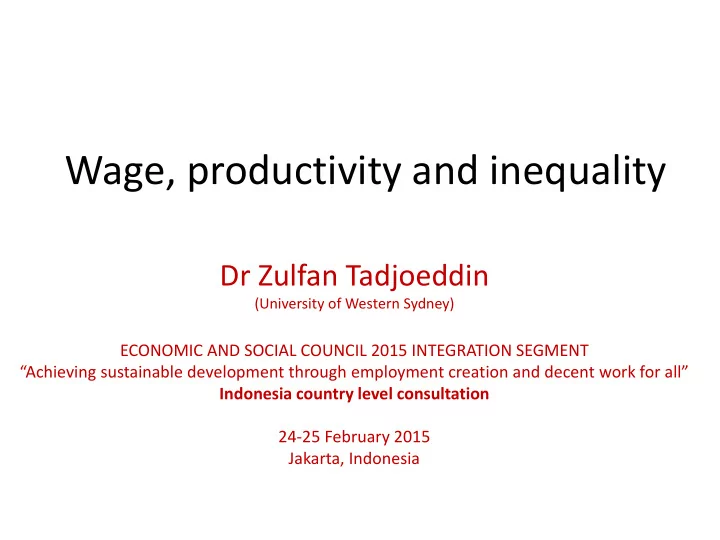

Wage, productivity and inequality Dr Zulfan Tadjoeddin (University of Western Sydney) ECONOMIC AND SOCIAL COUNCIL 2015 INTEGRATION SEGMENT “Achieving sustainable development through employment creation and decent work for all” Indonesia country level consultation 24-25 February 2015 Jakarta, Indonesia
Four Empirics 1) Inequality is rising; the true level of economic inequality is higher 2) De-linking between wage and productivity 3) Conventional wisdom of negative relationship between wage and employment But: 4) Large-medium establishment of manufacturing sector: the conventional wisdom does NOT hold. Productivity-wage-employment, all, move together, while the economy expands
(1) Inequality Inequality is rising; the true level of economic inequality is higher
Gini (expenditure – Income – Asset???)
Gini (expenditure – Income – Land)
Median to mean ratio of real earnings across employment status
(2) The de-linking: overall economy most of economic sectors most of provinces
Pre & post crisis • Pre 1997/8: Growth in wage earnings kept its pace with productivity growth • 2001-12: real earnings only grew at 0.2% annually, while productivity grew at an annual rate of 5.4 %, comparable to the pre-crisis period.
De-linking between wage and productivity (2001 = 100)
Wage as % of productivity
Wage as % productivity in 33 provinces 2001-11 1) Decreasing slope: 17 prov (growth centre) 2) Constant slope: 8 prov 3) Increasing slope: 8 prov ( productivity)
Decreasing slope in 17 provinces
Constant slope in 8 provinces
Increasing slope in 8 provinces but, due to declining productivity
(3) The de-linking explains the conventional wisdom of negative relationship between wage and employment
Panel data (33 provinces; 2001-2012) 9 economic sectors • Wage = f { Productivity, lag-Wage) • Employment = f {Wage, lag-Employment)
Panel data (ISIC 3 level; 2001-2012) LM manufacturing only • Wage = f { Productivity, lag-Wage) • Employment = f {Wage, lag-Employment) Ideal scenario: productivity, wage, employment The importance of the modern and more organised LM manufacturing
Endogenous Wage (System GMM) Exogenous Wage 1st step 2nd step System GMM (LnW=LnProd, lagLnW) (LnE = pred_LnW, lagLnE) (LnE = LnW, lagLnE) Prod coef. Remark Wage coef. Wage coef. (1) (2) (3) -0.002 -0.169 *** -0.043 *** ALL De-linking Manufacturing- 0.033 -3.887 *** -0.012 ALL De-linking Manufacturing- LARGE and MEDIUM NOT a case 0.243 *** 0.552 *** 0.009 *** industry of de-linking
Marginal product, average product and wage
Rightward shifts of MP & AP
Demand & supply of labour
Minimum wage 1) Positively correlate with productivity Additional benefits 2) Lowers poverty 3) Lowers inequality
Productivity
Recommend
More recommend